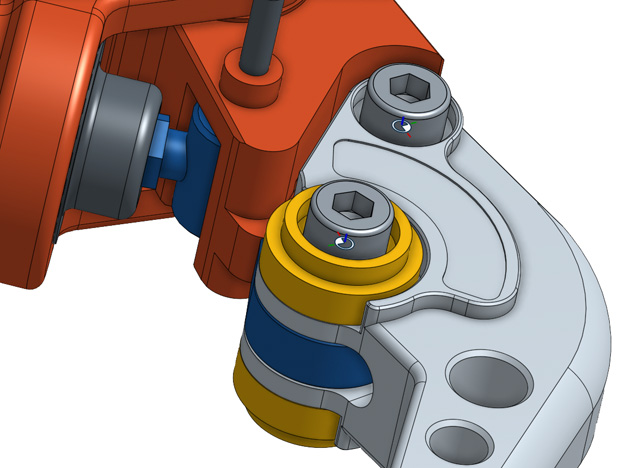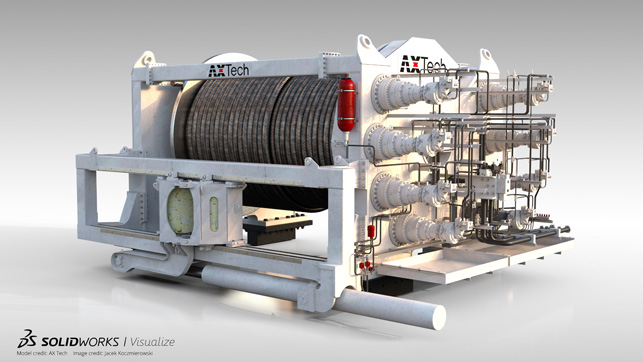
3D CAD
3D CAD applications are generally singlethreaded, which means most of their operations run on a single CPU core. As a result, it’s important to prioritise frequency (GHz) over the number of cores. A quad-core or six-core processor should serve you well.
We’d recommend the Intel Core i7-8700K (six cores, 12 threads) (3.70 GHz, 4.70 GHz Turbo). The Intel Core i7-9700K (eight cores, 16 threads) (3.60 GHz, 4.90 GHz Turbo) has a slightly higher spec for virtually the same price, but is only currently available from specialist manufacturers. The additional two cores may be useful if you also use a multithreaded ray trace rendering tool like KeyShot.
The Intel Core i5-9600K is a good budget choice. It has six cores and 6 threads, so you’ll lose a little bit of performance if rendering, but with a base of 3.70GHz and a Turbo of 4.60GHz it’s great for 3D CAD.
But, like the Core i7-9700K, it is not yet widely available.
Intel Xeon E-2000 series CPUs are another option, but it’s important to note that any Xeon models with six cores or more require the special Windows 10 Pro for Workstation (4 Cores Plus) OS, which costs over £100 more than standard Windows 10 Pro.
The 3D graphics requirements for CAD are quite moderate as most software is CPU-limited.
As long as your GPU has a certain level of processing power, 3D performance will then be dictated by CPU frequency. In such cases, a high-end GPU is pointless, as most of its resources will not be used.
For smaller assemblies, we’d recommend the Nvidia Quadro P1000 or AMD Radeon Pro WX 4100; for larger assemblies, the Quadro P2000 or Radeon Pro WX 5100. Higher-end GPUs may give a performance boost when viewing models with realistic materials and lighting.
For memory, use a minimum of 16GB DDR4 RAM, although 32GB should give you some headroom for the future.
For storage, NVMe SSDs are ideal and are now relatively cheap, although don’t feel you have to buy an expensive 2TB SSD to store your CAD files.
A combination of 256GB or 512GB SSD and a 2TB HDD will serve you perfectly well.

CPU rendering
For a CPU renderer like KeyShot or V-Ray, or any of those built into 3D CAD applications, more cores will generally deliver renders much quicker. But don’t forget about frequency (GHz), which is as essential for general system performance as it is for applications and 3D graphics.
Historically, design viz folks have had to strike a balance between cores and GHz. As the number of cores increases, GHz generally goes down. But now they really can have their cake and eat it too. And, for the first time in years, AMD is giving Intel a serious run for its money.
The AMD Ryzen Threadripper 2990WX, for example, is a 32-core, 64-thread monster with a base frequency of 3.0GHz and a Turbo of 4.2GHz. It’s phenomenally fast at ray trace rendering, but it also plays nicely with CAD (and with your wallet as it only costs £1,333 Ex VAT).
Despite its obvious attraction, Threadripper is only available in workstations from specialist manufacturers.
AMD might currently have the performance crown for rendering on a single CPU, but Intel is fighting back. The Intel Xeon W-3175X, due to ship any day now, boasts 28 cores, 56 threads, a base frequency of 3.1GHz and a Turbo of 4.3GHz. On paper, it should offer better performance than Threadripper, but rumours suggest it’ll cost a lot more.
For those on tighter budgets, AMD and Intel also offer several cheaper models with fewer cores. Check out the AMD Ryzen Threadripper 2950X (16 cores, 32 threads, 3.50GHz, 4.40GHz Turbo) and Intel Core i9-7940X (14 cores, 28 threads, 3.1GHz, 4.3GHz Turbo).
With such great price/performance on offer from single CPU workstations, the role of the dual Xeon has been somewhat diminished, but a pair of 18-core Intel Xeon Gold 6154 CPUs will still give the best rendering performance.
For memory, choose a minimum of 32GB DDR4, but 64GB or 128GB will be needed for large datasets. For storage, NVMe SSDs are a given, but consider the Intel Optane SSD 905P for really demanding I/O.
Graphics should be matched to your 3D workflows, whether that’s 3D CAD, real-time viz or VR – see other sections.

GPU rendering
GPU rendering in product development is still relatively niche but the applications are growing.
Examples include SolidWorks Visualize, V-Ray NEXT GPU and Radeon ProRender.
Most GPU renderers use Nvidia CUDA, so only run on Nvidia GPUs. Others use OpenCL, so run on AMD or Nvidia.
GPU renderers need a GPU with lots of cores and memory.
8GB is really a minimum, with 16GB, 32GB, or even more needed for complex datasets.
Generally speaking, with Nvidia GPUs, if you run out of GPU memory, the scene will not render. AMD ‘Vega’ GPUs give you some headroom by allowing GPU memory to spill over into system memory. CPU renderers don’t have the same memory challenges, as you can simply add more to your workstation.
AMD GPUs are good at multitasking (i.e. 3D graphics and rendering at the same time); Nvidia GPUs less so.
GPU renderers can make use of multiple GPUs. This is a big benefit over CPU rendering, as it’s easy to add more processing power to your workstation.
However, your machine will need spare PCIe slots and a high-wattage power supply.
Using multiple GPUs does not generally increase the amount of GPU memory that can be used by the renderer.
However, with Nvidia NVlink technology, you can double the memory by effectively turning two GPUs into one. NVlink is only supported with high-end GPUs like the Quadro GV100.
You don’t need a professional GPU to use a GPU renderer, so some users choose a consumer GPU instead. You get significantly more for your money, but consumer GPUs generally have less memory and are usually not certified for pro applications like CAD. You can’t mix consumer and professional GPUs in the same workstation.
Nvidia has built ‘AI denoising’ into its ray tracing engine, which can dramatically cut render times, giving GPUs a potentially big advantage over CPUs. AMD is doing similar.
Nvidia is betting big on rendering, promising ‘realtime’ ray tracing with its new Quadro RTX GPUs, which feature dedicated cores for ray tracing and deep learning.

Real time Viz/VR
The graphics requirements for real-time viz are much higher than they are for 3D CAD. With an emphasis on realism and silky smooth frame rates (30FPS+), you need a high-end GPU to do it justice.
Real-time viz tools like Autodesk VRED are built from the ground up for professional use, so generally benefit from a high-end professional GPU (Nvidia Quadro or AMD Radeon Pro). Such GPUs are certified to be used with key applications, which can give users confidence in stability, performance and display accuracy.
A good starting point is the Quadro P4000, but most viz workflows will demand a significantly more powerful GPU, especially on 4K displays.
Some applications will benefit from multiple GPUs.
Conversely, game engine viz tools like Unreal Engine will work fine with consumer GPUs. However, pro GPUs do generally offer more memory, which can mean geometry and materials do not have to be optimised/simplified as much.
VR has even bigger demands. It requires around eight times more graphics processing power than is needed to view the same scene on a FHD (1,920 x 1,080) display. This is because head mounted displays (HMDs) need to render both eyes at very high frame rates (90FPS) for a comfortable VR experience.
For viewing simple models in an application like SolidWorks eDrawings 2019 or VR4CAD, a Quadro P4000 should do a good job. But, for larger assemblies, especially when there needs to be an emphasis on visual quality with anti aliasing and realistic materials, you’ll need a Quadro P5000 or above.
The most important thing to understand about VR is that if you don’t correctly match your GPU to your workflow, it will simply not work for VR. This is different to viewing a 3D model on a desktop display, where slow frame rates will usually just give you a sub-optimal experience.
In terms of the workstation, for both real-time viz and VR, you’ll need a high frequency CPU – the Intel Core i5-9600K or Core i7-8700K are good starting points. You’ll also need lots of memory (32GB+) and a fast NVMe SSD.
This article is part of a DEVELOP3D workstation special report. To read articles and reviews in this report click on the links below.
Review: SolidWorks 2019 – getting more out of your GPU
Review: Dell Precision 5530 2-in-1
Your workstation can never be fast enough
Review: Samsung portable SSD X5






